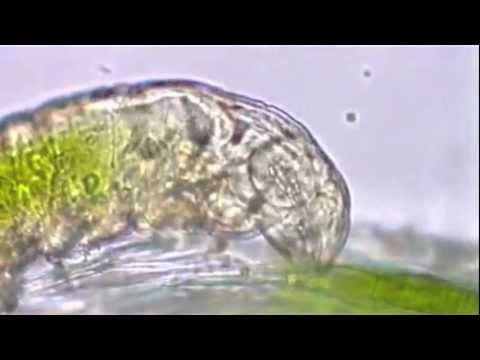国立極地研究所の研究者らは、1983年11月に南極昭和基地周辺で採取されたコケ試料を30年ぶりに解凍し、コケ試料中に含まれていたクマムシの個体を蘇生させ繁殖能力を確認することに成功しました。
餌のクロレラを与えて飼育すると、1匹はあまり食べずに死んだが、もう1匹は5回産卵し、14匹がかえった。また、コケの中から卵が見つかり、水につけると6日後にかえり、餌を与えると成長して産卵した。 (毎日新聞2016年1月15日)
Long-term survival has been one of the most studied of the extraordinary physiological characteristics of cryptobiosis in micrometazoans such as nematodes, tardigrades and rotifers. In the available studies of long-term survival of micrometazoans, instances of survival have been the primary observation, and recovery conditions of animals or subsequent reproduction are generally not reported. We therefore documented recovery conditions and reproduction immediately following revival of tardigrades retrieved from a frozen moss sample collected in Antarctica in 1983 and stored at −20 °C for 30.5 years. We recorded recovery of two individuals and development of a separate egg of the Antarctic tardigrade, Acutuncus antarcticus, providing the longest records of survival for tardigrades as animals or eggs. One of the two resuscitated individuals and the hatchling successfully reproduced repeatedly after their recovery from long-term cryptobiosis. This considerable extension of the known length of long-term survival of tardigrades recorded in our study is interpreted as being associated with the minimum oxidative damage likely to have resulted from storage under stable frozen conditions. The long recovery times of the revived tardigrades observed is suggestive of the requirement for repair of damage accrued over 30 years of cryptobiosis. Further more detailed studies will improve understanding of mechanisms and conditions underlying the long-term survival of cryptobiotic organisms. (Tsujimoto et al., Cryobiology doi:10.1016/j.cryobiol.2015.12.003)
クマムシは体長1ミリ弱程度の、比較的どこにでも生息している生き物です。
「たるに変身 クマムシ(Water Bear)の秘密」 (乾眠する様子 3:01-)
クマムシはありきたりな生き物であるにもかかわらず、極端な低温や高温、真空、高圧、放射能などに耐えて生き延びることができることから、地球最強の生物と目される非常にユニークな存在です。
クマムシさんのうた(科学未来館フルバージョン)
Water Bear Don’t Care – SciTunes #14
クマムシの英語名は、Tardigradesですが、熊のようにのそのそ歩くことからwater bearとも、また、苔が好物なことから、moss pigletsとも呼ばれます。
Tardigrades Are Weird, Gross & Beautiful (ケイティ・ウェイン(Catie Wayne)によるクマムシの紹介動画)
クマムシは、極端な乾燥条件では代謝活動を停止するクリプトビオシスと呼ばれる状態になります。水分が補給されると再び生命活動が始まります。
乾眠してから復活するヨコヅナクマムシ (クマムシ博士の動画)
Tardigrades and Cryptobiosis (クリプトビオシスの説明 2:49-)
参考
- Recovery and reproduction of an Antarctic tardigrade retrieved from a moss sample frozen for over 30 years. (Cryobiology Available online 25 December 2015 doi:10.1016/j.cryobiol.2015.12.003 Megumu Tsujimoto, Satoshi Imura and Hiroshi Kanda)
- 南極のクマムシ、30年を超える凍結保存から目覚め、繁殖に成功 (国立極地研究所 プレスリリース 2016年1月14日):”国立極地研究所(所長:白石和行)の辻本 惠 特任研究員を中心とする研究グループは、南極昭和基地周辺で1983年11月に採取され、30年と半年の間凍結保存されていたコケ試料からクマムシを取り出し、その蘇生直後の回復と繁殖(注1)の様子を記録することに成功しました。クリプトビオシス(注2)能力を持ち、「最強動物」とも呼ばれるクマムシの、これまでの最長生存記録は乾眠(注3)状態の室温保存で9年でしたが、今回の研究ではその記録を大幅に更新しました。”
- クマムシが30年ぶりに覚醒 (むしブロ クマムシ博士のドライ日記 2016-01-12)
- クマムシ30年冷凍、蘇生 南極で採取、産卵・繁殖も (毎日新聞2016年1月15日)
- 30年以上前に南極で採取されたクマムシが蘇生して繁殖! – 極地研 (マイナビニュース 2016/01/15)
- 高知大学キャンパス内のクマムシ
